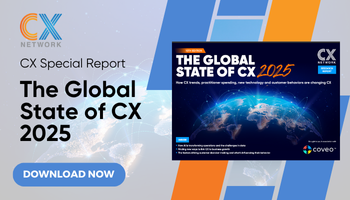How to grow your customer base
Growing the customer base is the top strategic CX aim for our community in 2024. Nick Glimsdahl explains how to do it without doubling marketing spend
Add bookmark
Imagine doubling your customer base without doubling your marketing budget. Sounds impossible? It's not. The secret to explosive growth in 2024 isn't about casting a wider net – it's about fishing smarter and providing value first.
Data from Harvard Business Review shows that increasing customer retention rates by just five percent can boost profits by 25-95 percent. Or as Forbes puts it, it costs five times more to attract a new customer than to keep an existing one. These statistics reveal a powerful truth: sustainable growth comes from nurturing relationships and consistently delivering value.
According to CX Network’s research into the Global State of CX this year, growing the customer base is the number one strategic aim for the global CX community at present.
As we approach 2025, successful businesses are shifting their focus. They're moving away from aggressive acquisition tactics and towards strategies that prioritize value creation. This approach doesn't just grow your customer base – it builds a loyal community that fuels your business for years to come.
Understanding your current customers
The foundation of growth lies in deeply understanding your existing customers. Analyze your customer data to identify your most valuable segments. Use surveys and feedback mechanisms to gain insights into their needs, preferences and pain points.
But don't stop at collecting feedback – act on it. When customers see that their input leads to real improvements, it builds trust and loyalty. Implement changes based on customer suggestions, then communicate these changes back to your customers. Show them how their input has directly improved your products or services.
Retention: The key to sustainable growth
While attracting new customers is important, retaining existing ones is often more cost-effective and valuable. Provide exceptional customer service at every touchpoint and create personalized experiences using the data you've collected.
Focus on increasing customer lifetime value by consistently delivering more value than expected. A satisfied customer who feels they're getting great value is more likely to become a repeat customer and brand advocate.
Targeting new customers
When targeting new customers, lead with value. Use data analytics to identify potential new customer segments, then develop targeted campaigns that focus on solving their problems or meeting their needs, not just selling your product.
Create detailed buyer personas for each segment, then craft value-packed content that addresses their unique challenges. For instance, if you're a fitness app targeting busy professionals, offer a free guide on "5-minute workouts for busy executives" before pitching your app.
RELATED CONTENT: The A-Z of creating modern customer personas
Leveraging technology to deliver value
Use technology to enhance your value delivery. AI and machine learning can help personalize content and product recommendations. Chatbots can provide instant, 24/7 support. Augmented reality can offer unique, valuable experiences, like virtually trying on clothes or visualizing furniture in a home.
Building community connections
Create a community around the value you provide. Host events, webinars or workshops that offer genuine value to attendees. Build online forums where customers can share insights and experiences. Encourage user-generated content that showcases how customers are benefiting from your products or services.
For example, an outdoor equipment company might sponsor local hiking or camping trips, providing an opportunity for customers to use their products in real-world settings and connect with other outdoor enthusiasts. Online, they could create a forum where customers can share trip reports, product reviews and outdoor tips.
RELATED CONTENT: Three brands taking community to the next level
Guiding customers through their journey
Remember, customers spend 70 percent of their buying journey researching independently. Make sure your online presence provides valuable information at every stage. Create informative content that educates customers about their problems and potential solutions, not just your products.
Develop a clear customer journey map and provide value-adding content at each stage. Offer detailed FAQs, buying guides and comparison tools. Consider providing proof of concept trials or demos to let potential customers experience your value firsthand.
One effective way to educate your prospects is through short, engaging videos. These can explain complex concepts, demonstrate product features, or provide industry insights. Tools that create video avatars offer a great resource for creating videos with realistic-looking avatars, which can add a personal touch to your content without the need for expensive video production.
For instance, if you sell complex software, you might create a series of short tutorial videos showing how to use different features. These could feature a generated avatar guiding viewers through each step, making the content more engaging and relatable. You could also offer a free trial period, allowing potential customers to experience the benefits of your product firsthand before making a purchase decision.
By providing this kind of valuable, educational content, you're not just informing potential customers, you're building trust and positioning your brand as a helpful authority in your field. This approach can significantly shorten the sales cycle and improve conversion rates, as customers come to you already educated about your product and its benefits.
Measuring and optimizing growth
Set clear, measurable goals for both the value you're providing and your customer growth. Track metrics like customer satisfaction scores, Net Promoter Score, and customer lifetime value alongside acquisition and retention rates.
Regularly review these metrics and adjust your strategies based on what the data tells you. Always ask: "Are we providing enough value to justify customer loyalty and growth?"
For example, if you notice your churn rate increasing, you might survey customers who have left to understand why, and then use that information to improve your product or service. If your customer acquisition cost is rising, you might need to refine your marketing strategies or explore new channels.
Ethical considerations
As you grow your customer base, maintain high ethical standards in all your business practices. This isn't just about doing the right thing – it's also a powerful way to build trust and long-term relationships with your customers.
Be transparent about your products and services. Your prospects will trust you more if you explain clearly what your product can and can't do. Remember, you can't be a good fit for everyone, and that's okay. By being upfront about your limitations will attract customers who are a genuinely good fit for your offering, leading to higher satisfaction and loyalty in the long run.
For example, if your software doesn't have a certain feature that some potential customers might need, be clear about this. You might say: "Our product excels at X and Y, but it doesn't currently offer Z. If Z is crucial for your needs, we might not be the best fit for you right now."
This honesty might lose you some initial sales, but it will earn you trust and respect. Customers appreciate companies that prioritize their needs over making a quick sale.
Be equally transparent about your data practices. Clearly communicate how you collect and use customer data. Give customers control over their information, including the ability to opt out of data collection or delete their data if they choose.
When marketing your products or services, avoid using manipulative tactics or making promises you can't keep. Instead, focus on the genuine value you provide and let that speak for itself.
By prioritizing ethical practices and transparency, you not only build trust with your customers but also create a sustainable foundation for long-term growth. Remember, in the age of information, reputation is everything. A strong ethical stance can become a powerful differentiator in a crowded market.
RELATED CONTENT A step-by-step guide to building customer loyalty
Looking ahead: Trends for 2024 and beyond
Stay ahead of the curve by predicting upcoming shifts in consumer behavior and preparing for new technologies that may impact customer interactions. The business landscape is constantly evolving, so remain adaptable to changing market conditions.
Growing your customer base in 2024 and beyond requires a holistic approach.
By consistently delivering value, you not only attract new customers but create a loyal community that fuels sustainable growth. Remember, the goal isn't simply to acquire customers, but to build lasting, mutually beneficial relationships based on trust and value.
Success in growing your customer base doesn't happen overnight. It requires a consistent commitment to providing value, a willingness to adapt based on customer feedback, and genuine dedication to improving customers' lives or businesses. By implementing these value-first strategies and continuously refining your approach, you can build a strong, loyal customer base that will support your business growth for years to come.
Special Report: The Global State of CX

Tenth annual flagship report. AI has transformed CX, raising expectations with investment in AI for CX automation, machine learning, and conversational AI now a top priority. Download the Global State of CX to learn how the industry is preparing for the new AI first future.
Download Now
























